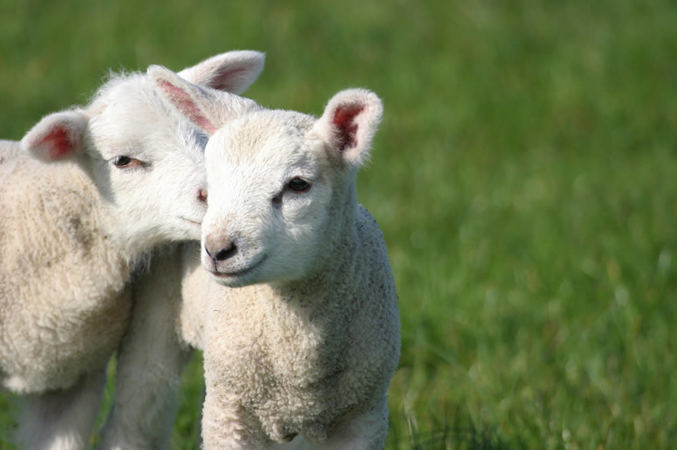Dairy farming has been part of agriculture for thousands of years. Dairy cows are bred specifically to produce large quantities of milk.
Dairy cows are required to give birth to one calf annually in order to produce milk for 10 months of the year. They are usually artificially inseminated within three months of giving birth.
Dairy cows can often only produce very high milk yields for an average of 3 years, after which they are slaughtered and the meat is normally used for beef.
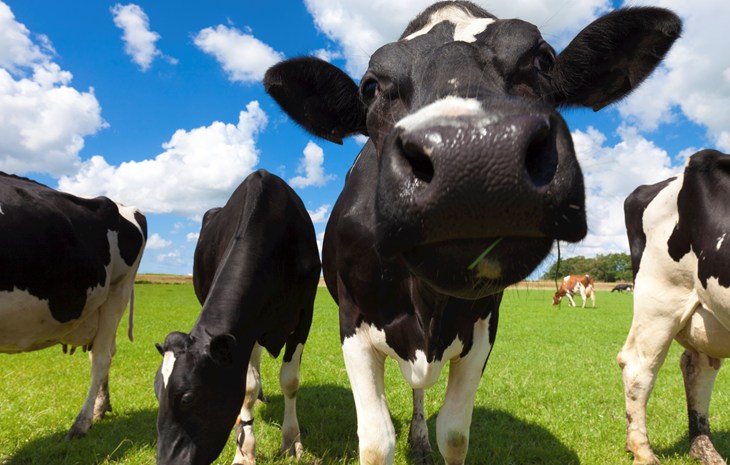
Global milk production
There are over 270 million cows producing milk across the world. The European Union is the largest milk producer and has about 23 million dairy cows. This compares with 10 million in North America and over 6 million in Australia and New Zealand. Milk production is also on the increase in South-East Asia, including countries not traditionally noted for their milk consumption, such as China, which now has over 12 million cows producing milk.
Intensive dairy farming results in an increasing number of welfare problems for dairy cows.
Welfare issues for dairy cows
Good animal welfare depends on three components:
- Physical well-being
- Mental well-being
- Natural living.
In intensive dairy farms, all three of these are compromised by periods of confinement in indoor housing, health problems due to higher milk yields and distress caused by early separation from their calves.
Higher milk yield
Over the last fifty years, dairy farming has become more intensive to increase the amount of milk produced by each cow. The Holstein-Friesian, the most common type of dairy cow in the UK, Europe and the USA, has been bred to produce very high yields of milk. Milk production per cow has more than doubled in the past 40 years. An average of 22 litres per day is typical in the UK, with some cows producing up to 60 litres in a day during peak lactation. The average yield in the US is even higher, at over 30 litres per day.
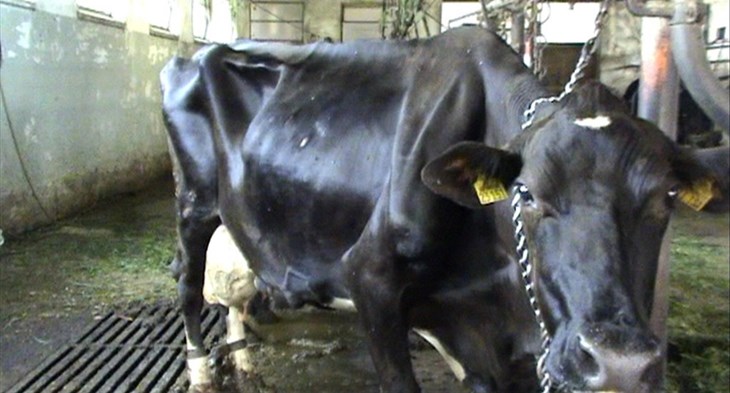
Given a natural healthy life, cows can live for twenty years or more. High-yielding dairy cows will typically be slaughtered after three or four lactations because their milk production drops and/or they are chronically lame or infertile.
Lameness, mastitis and infertility
Lameness is painful and a significant welfare problem for dairy cows worldwide. Cows may go lame due to various conditions associated with bacterial infection, such as hoof lesions, sole ulcers, laminitis and digital dermatitis. These conditions can be caused by poor quality floors, ineffective foot trimming, poor nutrition and prolonged standing on concrete floors.
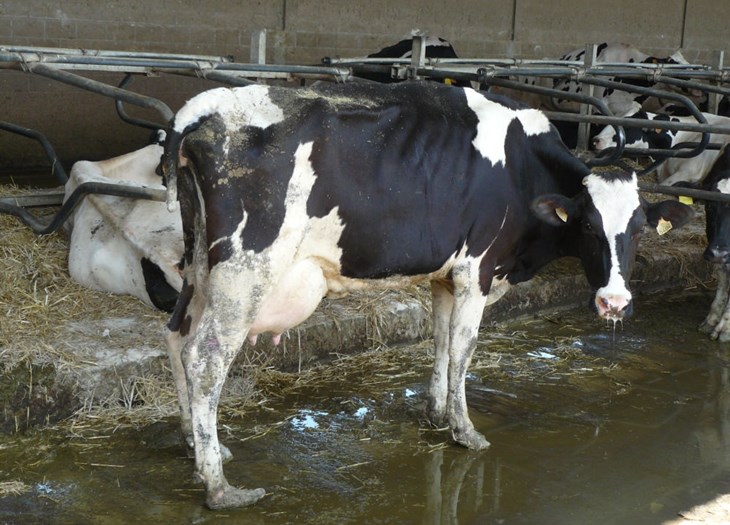
Malnourished cow with overgrown hooves
Mastitis, inflammation of the udder, is the painful result of bacterial infection that is prevalent among dairy cows. In a herd of 100 cows in the UK, there could be as many as 70 cases of mastitis every year on average. A cow’s udder can become infected with mastitis-causing bacteria due to contamination of milking equipment or bedding. Therefore cows that are housed for long periods of time are more likely to develop mastitis than those kept at pasture.
Cow infertility is a major productivity problem for farmers with high-yielding dairy cows. It can be caused by nutritional deficiencies, stress and poor body condition, therefore it is often a sign of poor welfare.
Housing
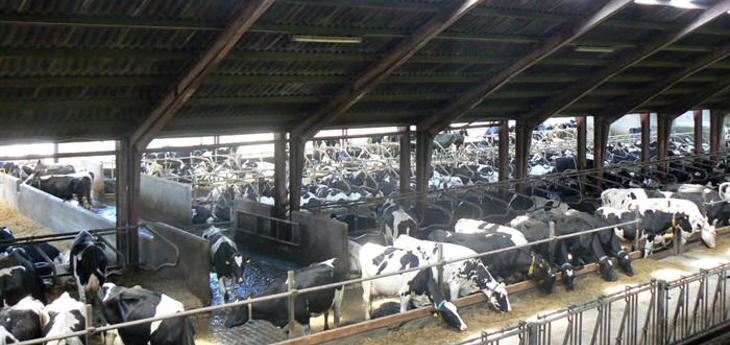
Most dairy cows will be kept indoors for part or all of the year. Cows typically have less opportunity to act naturally and exercise when indoors, compared to when they are at pasture, however indoor housing may be necessary during bad weather. Good housing design and management are essential for good welfare. Crowded conditions, poor ventilation and high humidity increase the injury and disease.
Rest is very important to cows, especially during lactation, and they need somewhere comfortable to lie. Cows that are kept on concrete floors with inadequate bedding, or in housing with poorly designed cubicles, will be more likely to develop mastitis. Hard flooring is also more painful for lame cows to stand and walk on, and cows may slip and injure themselves if floors are wet from excrement.
Tethering
Some cows are kept in tie-stalls, which involve severe confinement. Each cow is tethered by either a chain, stanchion (metal bars) or rope tied around the neck, for up to 24 hours a day throughout her life. Tie-stalls restrict every aspect of cows’ behaviour; they are unable to socialise, exercise and may even be unable to turn and scratch themselves.
Grazing
Cows need access to pasture with plenty of space and opportunity to graze. This is important for their physical and mental well-being, and their ability to perform natural behaviours. In the UK most dairy cows still have daytime access to grazing on pasture in summer, but more cows are being kept indoors for longer, or even all year round. This is known as ‘zero grazing’, and is increasingly used for large and high-yielding herds worldwide.
Zero-grazing systems
Diet
Cattle are ruminants that naturally graze or browse on grasses and other vegetation, therefore they require lots of fibre in their diet. However, dairy cows that produce high yields of milk require more nutrient-dense diets, so are fed more concentrates and less forage. This leads to a build-up of acids in the rumen (part of the stomach) which, if occurring for prolonged periods each day, causes acidosis. Cows with acidosis often have diarrhoea and can develop laminitis (damage to the feet that causes lameness).
Cows in organic systems receive a diet higher in fibre and have access to pasture during the grazing season.
In the US, many dairy cows are injected regularly with growth hormones (rBST) to increase milk yield. This is illegal in the EU.
Slaughtering dairy cows
When dairy cows become less productive or have significant health problems, they may be transported long distances to be slaughtered. This is because few slaughterhouses deal with spent dairy cows.
'Surplus' dairy calves

Naturally, calves suckle from their mothers for up to a year, and maintain a strong bond with her for several years. However in commercial dairy farming, nearly all calves are taken away from their mother within hours of birth. This causes severe distress to both the cow and the calf, and has long-term effects on the calf’s physical and social development.
Most female calves will be reared to join the milking herd but as male calves cannot produce milk, they are considered surplus to the dairy industry. Male calves will either be shot after birth, or sold to be reared for veal or beef.
Calves destined for the meat industry may be transported for several days over long distances by road and/ship, to rearing facilities which may be in different countries. This is very stressful and calves may be transported when only a week old. They will be hungry, tired, and fearful, and are particularly vulnerable to disease and injury at this age.
Due to cooperation between Compassion in World Farming, the RSPCA and the dairy industry (through the Calf Stakeholder Forum), more male dairy calves are now reared for meat and the number of calves being shot at birth has greatly decreased. There is more work to do – around 95,000 of those born in the UK are still shot every year. There has also been an increase in the production of higher welfare veal in the UK; it is better for calf welfare if consumers of veal choose British rose veal instead of imported white veal.
Higher welfare for dairy cows
We believe that cows should have access to pasture all year round, with the freedom to choose when they go outside or stay indoors. Housing should be well designed and cows should be given enough space for natural social behaviour. There should be plenty of bedding such as straw, so that cows have access to comfortable, clean spaces to rest. Diets should include plenty of fibre, and breeds that are prone to health problems should not be used. There are some systems that provide higher welfare for dairy cows.
Organic systems
Organic standards in the EU ensure that dairy cows have access to pasture during the grazing season and that cows are fed a more natural diet with plenty of roughage, which is good for their digestive health. They encourage better welfare and breeding in dairy cattle to reduce problems like lameness, mastitis and poor fertility.
Soil Association organic standards ban the sale of calves under one month old for export, or their sale at market under 12 weeks old (unless they are with their mother), and require farmers to work towards ending the killing of male calves at birth.
The organic dairy farm
Other pasture-based systems
Many traditional, smaller-scale dairy farms still keep cows on pasture during the grazing season.
In the US, the Animal Welfare Institute’s Animal Welfare Approved Standards require continuous pasture access for dairy cows. Certified Humane dairy standards prohibit certification of dairy systems that do not allow outdoor access, and encourage the meeting of dairy cows’ nutritional requirements through grazing on pasture where possible.
Dancing Cows
If there's still any doubt as to whether cows belong in fields, watch this video to see how they react when they are let out from their winter housing.
